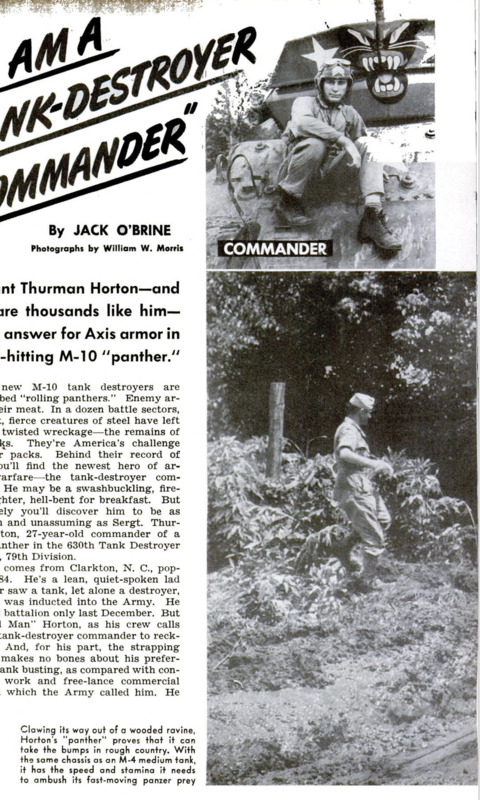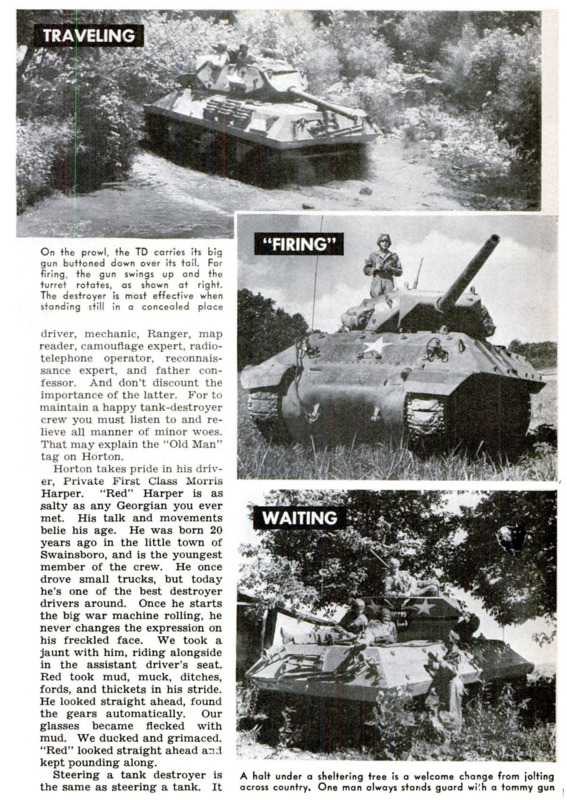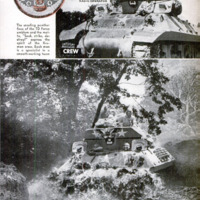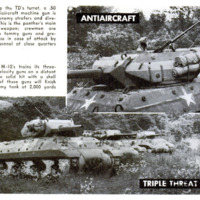-
Title (Dublin Core)
-
I am a Tank-Destroyer Commander!
-
Article Title and/or Image Caption (Dublin Core)
-
I am a Tank-Destroyer Commander! Sargent Thurman Horton - and there are thousand like him - has an answer for Axis armor in a hard-hitting M10 "panther".
-
extracted text (Extract Text)
-
OUR new M-10 tank destroyers are |
dubbed “rolling panthers.” Enemy ar-
mor is their meat. In a dozen battle sectors, |
these fast, fierce creatures of steel have left
a trail of twisted wreckage—the remains of |
Axis tanks. They're America's challenge |
to panzer packs. Behind their record of |
havoc, you'll find the newest hero of ar-
mored warfare—the tank-destroyer coms |
mander. He may be a swashbuckling, fire-
eating fighter, hell-bent for breakfast. But
more likely youll discover him to be as |
homespun and unassuming as Sergt. Thur-
man Horton, 27-year-old commander of a |
rolling panther in the 630th Tank Destroyer
Battalion, 79th Division.
Horton comes from Clarkton, N. C., pop-
ulation 484. He's a lean, quiet-spoken lad |
who never saw a tank, let alone a destroyer,
before he was inducted into the Army. He |
joined his battalion only last December. But
now “Old Man" Horton, as his crew calls |
him, is a tank-destroyer commander to reck- |
on with. And, for his part, the strapping |
sergeant makes no bones about his prefer- |
ence for tank busting, as compared with con- |
struction work and free-lance commercial
art, from which the Army called him. He
thinks his outfit's the best there is. That's
typical of a tank destroyer commander.
When we met him, his TD was easily dis-
tinguished from the others in the battalion.
On its turret was painted the snarling face
of a black panther—symbol of the Force.
Sergeant Horton stood by grinning a wel-
come.
Tank destroyers are relative newcomers
in America’s brood of war. The first com-
mand was formed in 1941, with Brig. Gen.
Andrew D. Bruce, then a lieutenant colonel
on the General Staff, as its chief. It went
into operation as great Ford and General
Motors plants began volume production of
the antitank weapon. Resembling closely
its mortal enemy, the M-10 consists of a
high-velocity gun mounted on an M-4 (me-
dium) tank chassis. Superior speed enables
it to beat the foe to positions of ambush, and
superior fire power enables it to make the
kill. Though but one twentieth of an inch
larger in bore than the famed 75-mm. gun,
the three-inch gun fires a much heavier shell
tipped with armor-piercing steel. A single
solid hit will destroy a tank at 2,000 yards.
In an Army that now boasts many thou-
sands of these deadly weapons, it's prob-
ably no great shakes to be the commander
of one. But from a tactical standpoint every
destroyer commander is highly important.
Each is a link in the chain of destruction
closing slowly but surely around Axis armor.
“Old Man” Horton knows this, as do the
four members of his crew. They also know
their job is rough, tough, and fraught with
danger—and they love it.
Their training has the realism of war.
Their rolling panther—33 tons of low-sil-
houetted steel and lead and gunpowder—is
their textbook, and rugged, ravine-gashed
countryside is their classroom. They learn
the hardships, strain, and glory of actual
combat. They learn to embrace the motto
of their streamlined outfit: “Seek, strike,
destroy!”
When we talked with Horton, he and his
turtle-helmeted crew were nearing the fin-
ish of their training course. The destroyer
commander said they were ready for the real
thing and wanted it badly. Yet, only a few
months earlier, they all had been novices in
armored warfare. None had so much as an
inkling of what was before him when he
suddenly found himself assigned to the de-
stroyer unit. They got their basic at de-
stroyer schools, where each man became a
specialist in his own right.
As prospective commander, Horton got
the works. He learned to be artilleryman,
driver, mechanic, Ranger, map
reader, camouflage expert, radio-
telephone operator, _reconnais-
sance expert, and father con-
fessor. And don't discount the
importance of the latter. For to
maintain a happy tank-destroyer
crew you must listen to and re-
lieve all manner of minor woes.
‘That may explain the “Old Man"
tag on Horton.
Horton takes pride in his driv-
er, Private First Class Morris
Harper. “Red” Harper is as
salty as any Georgian you ever
met. His talk and movements
belie his age. He was born 20
years ago in the little town of
Swainsboro, and is the youngest
member of the crew. He once
drove small trucks, but today
he's one of the best destroyer
drivers around. Once he starts
the big war machine rolling, he
never changes the expression on
his freckled face. We took a
jaunt with him, riding alongside
in the assistant driver's seat.
Red took mud, muck, ditches,
fords, and thickets in his stride.
He looked straight ahead, found
the gears automatically. Our
glasses became flecked with
mud. We ducked and grimaced.
“Red” looked straight ahead and
kept pounding along.
Steering a tank destroyer is
the same as steering a tank. It
requires skill, but it’s simple. You have
a lever in each hand. When you pull one, it
stops the track on that side, speeds up the
other track, veers you off. Working them
back and forth, right and left, you cause the
destroyer to weave from side to side. Shift
ing gears is more difficult, but any auto
driver can learn it easily. You have five
forward speeds. The big machine has no
brakes, 50 you have to shift to a lower gear
to slow down. It's done by double-clutching
—going into neutral, engaging the clutch,
bringing the engine speed into time with the
lower gear, then completing the shift.
‘Horton rides in the bowels of the panther
or atop the turret, when hitting the road.
Beside him are his gunner and assistant gun-
ner, Privates William F. “Pop” Jean, of
Buechel, Ky, and Ernest Hill, of Sweet-
water, Ala.” At 36, Jean Is the oldest in the
unit. Hill is 22. Fifth member of the crew is
Private First Class Wayne D. “Smitty” Ne-
Smith, 21, of Eastman, Ga., assistant driver
and radio operator.
When they get orders to stalk enemy
tanks, they employ the skill and audacity of
Indians, darting and slithering from cover
to cover. The long threc-inch gun is but-
toned down on the tail, and f there's danger
of enemy bullets the ports of the driver and
‘assistant driver also are buttoned down. The
driver and his aide see ahead through rec-
tangular periscope windows, six by 1 3/4
inches. An Intercommunication _system
‘makes possible constant contact with their
commander, who now and again may rise
above the open turret and take a spot-'em-
first Jook for the enemy. The radio operator
keeps in touch with battalion headquarters
and other units in the mission, including
mechanized reconnaissance forces that may
have flanked the foe's lines.
T's up to the tank-destroyer commander
to spot appropriate places of concealment.
In a good hiding place, the panthers can
“hull down" and lie in walt for approaching
enemy armor. Sometimes they withhold
their fire until unsuspecting tanks reach a
point only 500 yards away, and then slam
shells into the advancing tank column at the
rate of 25 shots a minute
“Then, if enemy artillery gets after them,
they can begin “getting the breeze" scoot:
ing to a healthier position. In their tactical
‘plans, the destroyers go in and out of hiding
‘many times a day.
In the North African campaign, tank-de-
stroyer commanders of the metal of Ser.
geant Horton won their share of fame. Fuxy
tank drivers of Herr Hitler's touted Afrika
Korps learned to give them a wide berth.
When enemy paratroopers attempted oc-
casionally to round up a panther crew, they
found themselves with a jungle cat by the
tail. For every man in a destroyer is armed
with a tommy gun, fn addition to hand
grenades and a rifle grenade.
Talk consumes a great deal of the time
when the crew is lying in concealment or
in bivouac. It's a luxury, for you can't talk
soldier talk while roaring and crashing
across the countryside in that lusty battle
machine. Also popular is “hittin’ the sod" — |
stretching full length on the ground with or
without bed roll. After jolting and banging |
in the destroyer, it's good to feel solid earth
underneath you. |
Once in a while you'll find the crew tidying
up. That's when they have the luck to locate |
a stream or pool. Then it's wash day, and
virtually everything comes in for a lather- |
ing. If there's time, even the destroyer gets
a bath, |
One man in the crew is kept on guard
every minute the camouflaged monster is |
parked. He usually sits astride the turret,
‘with his tommy gun slung handily across his |
knees. The men take turns at watch, in
stretches of two to four hours. The guard |
knows the peril of surprise attack. His ears
are trained to pick up sounds that might |
mean trouble. He's on the alert for enemy
patrols and reconnaissance units, night |
prowlers laden with lead and TNT. Should
they appear, he gives an alarm and an ap- |
propriate reception is arranged.
For daytime signaling, each destroyer car-
ries three flags—green, yellow, and red. In
the new fixed signals, different flags and
combinations of flags mean: “Enemy ap-
proaches”; “Attention. Are you ready?”
(when answered, “I am ready”) ; “Disregard
my last order”; “Do as I do”; “Disperse”;
“Increase space between vehicles, but main-
tain formation”; “Assemble”; “Gas attack,”
and other combat commands.
In addition to these signals, the destroyer
commanders make signs to one another with
their hands, employing the old system of
motions used by Army drivers. Use of radio-
telephones has cut down on the frequency
with which hand and flag signals are needed.
There are radios in each company of tanks,
and 18 in the battalion.
Tank destroyers are the most important
units in their battalion, but there's plenty of
added wallop. For instance, each jeep lugs
one of the now celebrated “bazookas”—
the new antitank blasters. Then there are
three-quarter-ton weapons carriers, half-
tracks mounting 50 caliber machine guns,
motor gun carriages with 37-mm. guns,
and no less than 25 cargo trucks with am-
munition and supplies.
But the rolling panthers are the beauties
with the big sockeroo, and commanders like
Sergt. Thurman Horton will see that the
enemy finds it out.
-
Contributor (Dublin Core)
-
Jack O'Brien (writer)
-
William W. Morris (photographer)
-
Language (Dublin Core)
-
eng
-
Date Issued (Dublin Core)
-
1943-10
-
pages (Bibliographic Ontology)
-
102-106
-
Rights (Dublin Core)
-
Public Domain (Google digitized)
-
Archived by (Dublin Core)
-
Matteo Ridolfi
-
Alberto Bordignon (Supervisor)
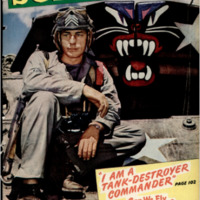 Popular Science Monthly, v. 143, n. 4, 1943
Popular Science Monthly, v. 143, n. 4, 1943

